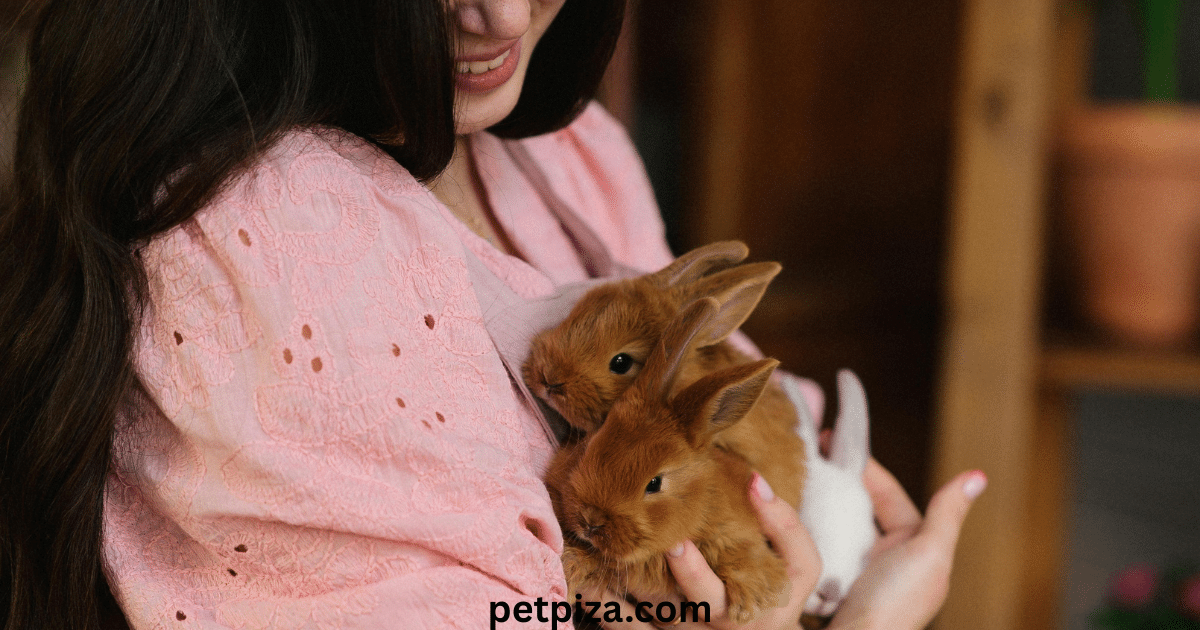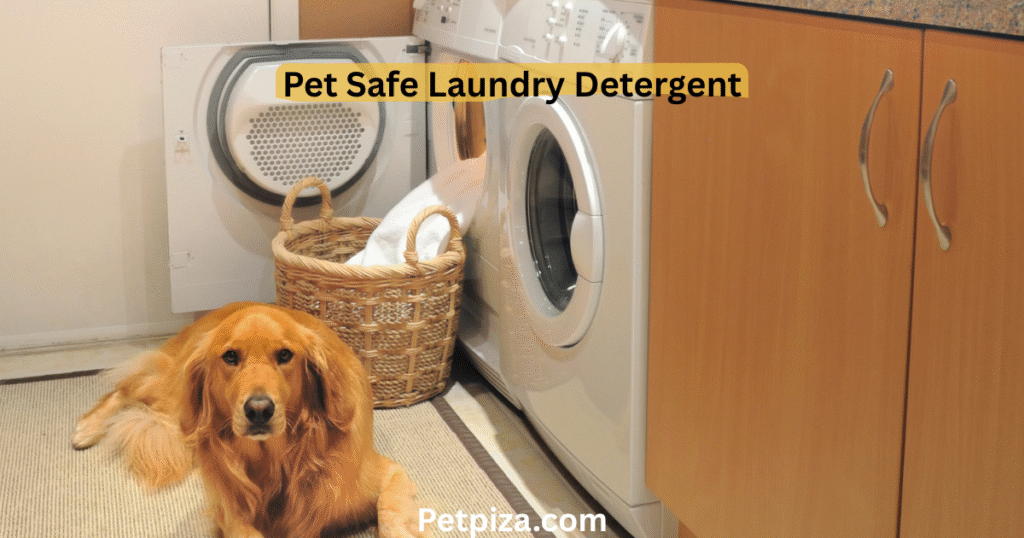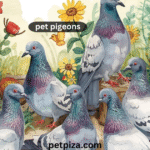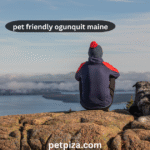Any pet owner will agree that no stone should be left unturned when it comes to maintaining the health and the happiness of your pet. This includes the food your lovely friend eats, the snacks it is offered, the bed it sleeps on, and the toys it plays with. However, what about the laundry detergent you use?
Your pet’s treasured spot probably includes a soft blanket, a plush bed, and more, all which probable fill and rotate with the laundry on a frequent basis. Detergents of the conventional kind can have a variety of negative tolls on the health of your furry friend, including pet skin problems.
This blog will focus on the importance of using a laundry detergent that is safe for animals. We will seek out the harmful ingredients that rest inside of any detergent, and what one should use in its absence, while also offering additional suggestions for a pet safe laundry routine. This easy switch will enhance your pet’s safety, and will aid in the promotion a healthy space that all individuals in your house can enjoy.

Pet safe LAUNDRY DETERGENT NEEDS a Special Detergent
A pet’s skin is unlike the skin of a human. It is more sensitive and more absorbent because of skin and fur, grooming, and bathing. Many animals, and especially cats and dogs, spend a lot of time licking their fur and paws. If an animal is lying on pet bedding that we have washed, with fabric softener and detergent that has fabric softener and other chemicals, that animal, through their skin or fur, is slowly and insidiously being poisoned. The fleece blanket or bedding that they are not washed to hide the residue but are also, to a large extent, ingesting the chemical residues left.
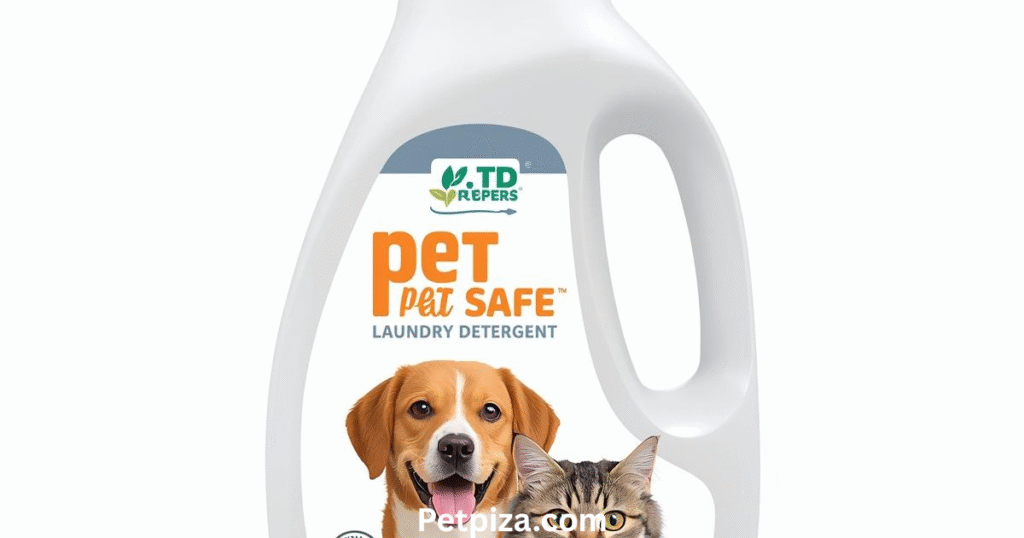
With this constant exposure, the following symptoms are a result.
- Skin Irritation: With constant exposure from residues left after the bedding is washed, the animal is likely to show signs of contact dermatitis. This is evidenced from redness, fur loss, rashes, hot spots, or an animal that has become restless, and is rubbing or scratching furiously at places to relieve the itch. It is easy to see how an animal that has not been washed in a long time is likely to also suffer from being told they are ‘dirty’. They become restless and tetchy rather than calm and happy.
- Allergic Reactions: The presence of artificial fragrances, and dyes, and preservatives can become more prominent. The skin, especially around or on the belly can become more swollen or red, or lesions noticed. Breathing issues become more noticeable, blunted or are accompanied with a cough, or watery or inflamed eyes.
- Risky Internal Health: Many checks are used to determine if an animal has been poisoned. Cabinet deodorants were often made of fabric sheets used to line a cupboard. Many animals have also been rather unattractively found lying in slow routes to chin, and often the adjective used is ‘unappealing.’ There is also a deadly risk of some products on the market can be bought to ‘clean’ teeth. The have chemical designs on over aggressive deodorizers, scented oils, and supposed ‘active’ foam cleaners.
Our pets cannot share their pain, so the symptoms will get diagnosis errors or misdiagnosis symptoms of allergies. Using non-phosphate detergents for pets can help to remove a frequent source of irritation and support their future wellbeing.
Toxic Detergent Ingredients to Be Selective About
The line of a detergent bottle can make a customer feel like the are halfway through a chemistry lesson. Remove and leave the considered chemicals that can ensure a safer pet use. One to watch for are as follows.
1. Infused fragrances and Phthalates
The phrase “Innocent until proven guilty” cannot apply to the “Fresh Linen” or the “Spring Rain” scent. As a “fragrance” or “parfum” they are shielded under the cloak and dagger of complex mixtures that can get home to chemical addicts. Used Phthalates are handy to keep the aromatic layers fresh for ages as the elites among fragrances go. We know, however, that they are known to disrupt endocrine cycles in/with animals.
2. Dyes
Likely for marketing reasons, the greenish blue hue your detergent takes on has no effectiveness towards cleansing. These synthetic dyes, such as other ones, are allergy and irratant risk to both pets and human beings. A truly safe cleaning product for pets, on the other hand, has no color, or is a safe, opaque whitish color.
3. Bleach (Sodium Hypochlorite)
Bleach is a potent sanitizing agent as a chlorinated liquid, but is seriously corrosive and poisonous if taken. Remaining on fabric can inflict burning and irritating skin damage, while the gaseous form impacts a dog, as an example, the negative effects are much more. For whitening and disinfecting, use a saponified soap, with oxidizing mask, composed of hydrogen peroxide and sodium percarbonate.
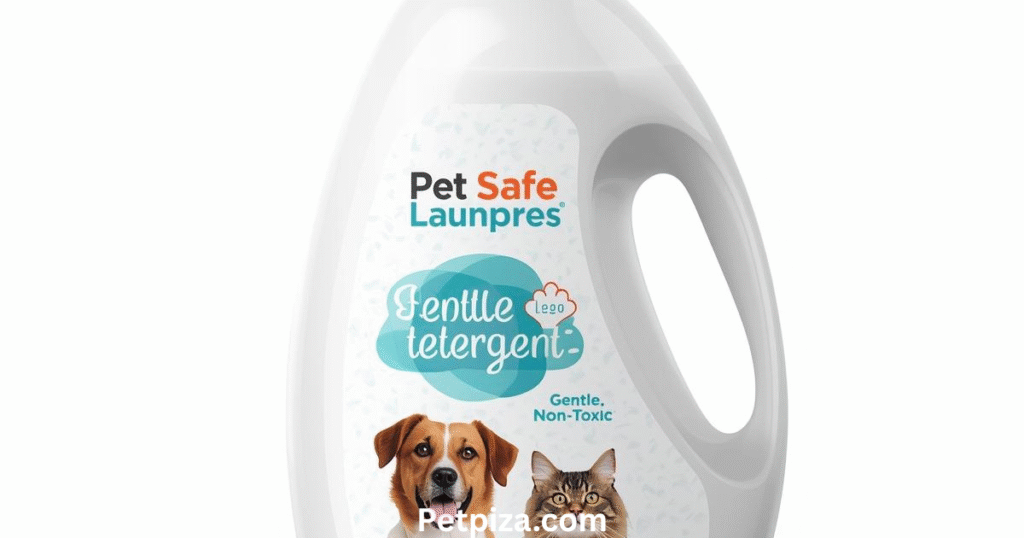
4. Sulfates (SLS and SLES)
Two of the most commonly used surfactants, sodium lauryl sulfate and sodium laureth sulfate, are among the most known skin irritants. Although effective for creating foam and lifting dirt, the SLS and SLES surfactants strip away the skin’s natural moisturizing barrier resulting in increased dryness, itching, and potential allergic reactions.
5. Phenols and Formaldehyde
Phenols are sometimes used for disinfecting due to their properties, but to pets, and especially cats, they are toxic because they cannot metabolize them due to the lack of appropriate liver enzymes. Formaldehyde, used as a preservative and antibacterial, is highly known for its harmful effects as a carcinogen, as well as causing major skin and respiratory irritation.
How to Choose the Best Pet Safe Laundry Detergent
Wading through the “green” and “natural” product marketing can be a challenge. Products labeled “plant-based” are not necessarily safe. Pet-safe products tend to use heavy marketing, but to identify the product if it meets your pet’s safety is best to follow this checklist.
Look for Hypoallergenic and Unscented Formulas
Look for the appropriate product and make sure its labeled “detergent” “hypoallergenic” and “fragrance free.” Unscented products may sometimes contain mask fragrances to cover the chemical odors. Fragrance-free is the word that confirms no scenting chemicals have been added.
Prioritize Plant-Derived and Enzyme-Based Cleaners
The best non-toxic pet safe Detergents contain plant-based surfactants such as coconut and natural enzymes that neutralizes odors and break down stains. Enzymes are proteins that assist in tackling specific messes:
- Protease: targets protein stains such as urine and blood.
- Amylase: tackles starchy stains.
- Lipase: works on oily stains.
Cleansers that use enzymes break down pet stains and remove odors easily and sanely.
Search for Third-Party Certifications
Certifications that have been independently verified should be sought. For example, the EPA’s “Safer Choice” logo means the product’s formulation contains safer chemicals for both people and the environment. Although not straightforward a “pet safe” certification, it is a strong sign that the product is free from many of the worse chemicals.
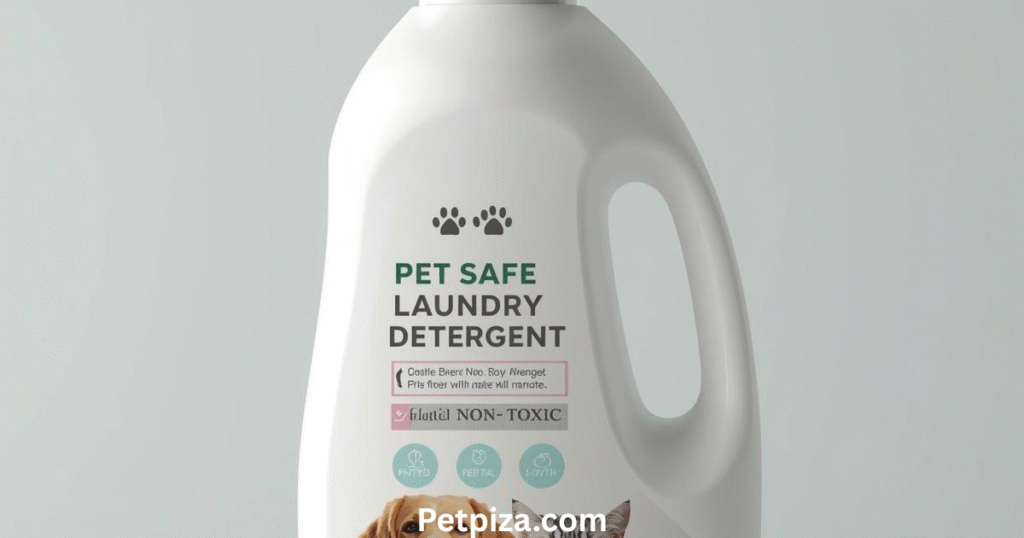
Go Through the Listing of All the Ingredients
Do not accept the fact that a company shows it’s proud of the item and advertising it on the front of the package. Instead, flip the package and closely examine the ingredients. Fewer the ingredients the better. Ensure they are basic and not jargons. If the list contains many complicated and incomprehensible and daunting chemical that are hard to pronounce, you might as well say bye to that option.
For Pet Safe Laundry Detergent
Numerous brands are renowned for making highly effective and safe cleaning products for pets. Although you should verify the specific formula, these brands are great places to begin your search.
- Seventh Generation Free & Clear within the category and is well within reach. Despite being a safe option for people with sensitive skin, it is used as a laundry detergent free of synthetic dyes, brightening agents, and artificial perfumes. Additionally, it is a USDA Certified Biobased Product.
- Better Life Unscented Laundry Detergent This brand doesn’t use synthetic fragrances, sulfates, or bleach and prides itself on cleaning agents derived from plants. Despite the brand’s gentle touch, it is known for its effectiveness.
- ECOS Hypoallergenic Laundry Detergent (Free & Clear) ECOS is a plant-science-powered and Safer Choice certified company. The moisturizing, Free & Clear formula that is pH-balanced and gentle on skin is ideal for its fragrance-free and sensitive skin qualities.
- Puracy Natural Laundry Detergent (Free & Clear) This formula which is plant-based and developed by doctors, uses stain removing enzymes. It is hypoallergenic and irritant-free, which makes it ideal for families with young children and pets.
More Pet Friendly Laundry Tips
Changing your laundry detergent is a big step, but you can add additional practices for a completely pet safe washing routine.
Wash Pet Bedding Regularly Cover the period that is aimed for washing pet peds, blankets, and soft toys that is once in 1-2 weeks (more if your pet has allergies or is dirty) particularly for winter. The reduction of dander, allergens, fur, allergens, and dirt is significant during this period.
Use an Extra Rinse Cycle When washing your pet’s belongings, use an additional rinse cycle which helps ensure that detergent residue is totally removed from the fabric.
- Ditch the Dryer Sheets: The majority of dryer sheets are covered with synthetic fragrances and softeners which get stuck on the fabric and leave behind a veil of chemicals on the material. For animals, this residue might turn a perfectly good piece of clothing into a major source of irritation. For this purpose dryer balls work best. Additionally, dryer balls will soften clothes, reduce static, and will probably decrease the time spent on drying.
- Remove stains with natural solutions: The best way to deal with a pet stain is to pre-treat it with a solution that is safe for pets. A little baking soda and water, or a solution of equal parts water and distilled white vinegar, will do the trick. since vinegar is a natural deodorizer, it will help neutralize the odor that urine has.
- Cleaning the washing machine: In reality, your washing machine is full of mold, mildew, and bacteria. To keep a machine clean and not full of old, musty odors that may sneak into the laundry, run a cleaning cycle on it every month with two cups of white vinegar and hot water.
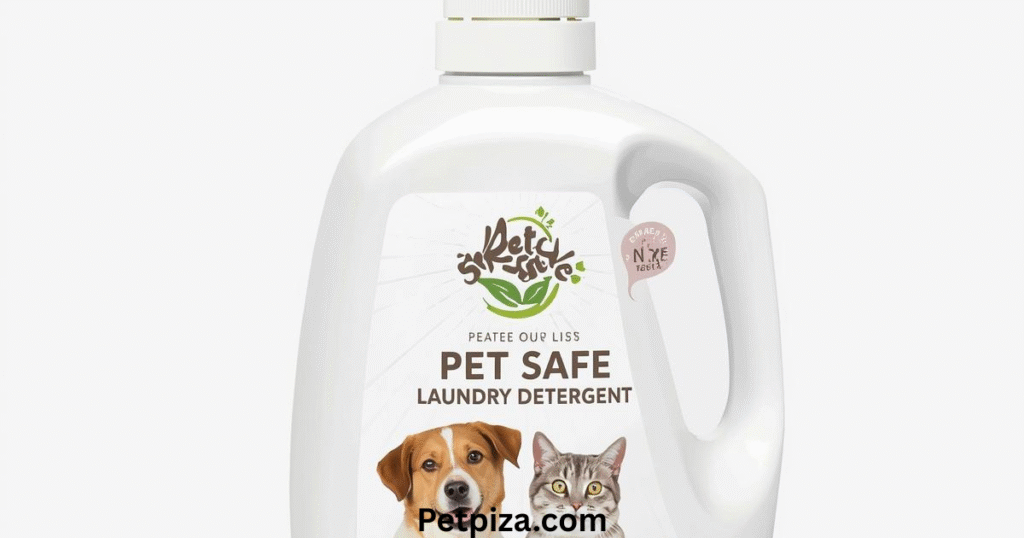
The Verdict: A Healthier Pet with Minimal Effort
The comfort and safety of our pets will always take precedence. Even though it could be an insignificant factor, the type of laundry detergent used can play an essential role in your pet’s daily health. Knowing which compounds are harmful and which are safe will help eliminate one of the hidden sources of toxins and allergens in your house.
A pet safe laundry detergent does not have to come at the expense of the detergent’s ability to clean. Advanced modern, plant and enzyme based pet laundry detergents work excellently to remove dirt, stains and odors. This mindful act of switching to a pet safe detergent gives you peace of mind knowing that you are contributing to a balanced healthy and happy life of your beloved pet.
